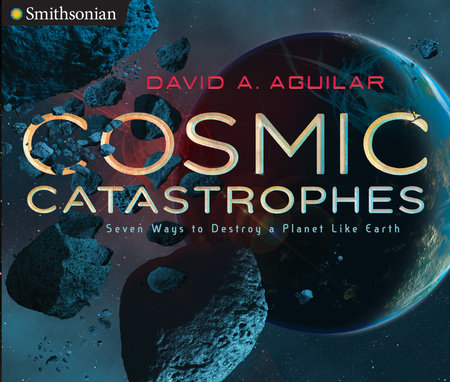In the vast realm of outer space, accidents happen all the time. Things bump into each other. Stars blow up. Space rocks smash into planets. Black holes gobble up everything in their path. The sun is burning out. A comet swarm is bearing down. Any of this could change—or even
eliminate—life on a planet like Earth.
Countdown to cosmic catastrophes!
From asteroid hit to alien invasion, astronomer David Aguilar builds the scientific case for seven extreme events that could impact Earth. (Though not as we know it: most of these catastrophes are way down the cosmic line . . .
we hope!) He tells an exciting nonfiction story about how and why these space catastrophes could happen and then creates beautiful, original art to show just how devastatingly spectacular it will be when any one of these seven “big ones” hit!
The SMITHSONIAN INSTITUTION is the world’s largest museum and research complex. Founded in 1846, it includes nineteen museum and galleries, the National Zoological Park, and nine research facilities. Its vast collections house 138 million artifacts, specimens, and works of art, which represent our nation’s rich heritage, art from across the globe, and the immense diversity of the natural and cultural world.
David Aguilar is an astronomer, artist, author of several notable books on space for children. He is the former Director of Science Information for the Harvard-Smithsonian Center for Astrophysics. As a member of the New Horizons Spacecraft Team, he handled the media coverage of the Pluto fly-by. He lives with his wife outside Aspen Colorado, where he’s built his own observatory. Asteroid 1990DA was named in his honor by the International Astronomical Union.
You can learn more at aspenskies.com.
Praise for Cosmic Catastrophes:★ "Readers who like their adventure and danger on a planetary scale will be captivated by this book . . . Outstanding." —
School Library Connection,
starred review"Chilling, compelling, and clearly explained . . . A wild and thought-provoking look at what potential calamities await our planet." —
School Library Journal



